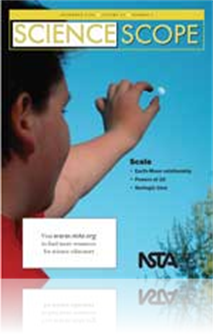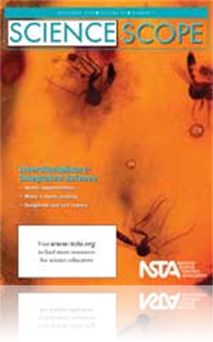All Science Scope resources
Journal Article
Science Sampler: Giants don’t exist in the real world—Challenges of teaching scale and structure
Issues that relate to the unifying theme of scale, as defined by the National Science Education Standards (NRC 1996) and Science for All Americans (AAAS 1989), are common in both science and everyday life. Until recently, there has been little resear...
Journal Article
The United States has a significant deficit in the number of university students choosing to major in science, technology, engineering, and mathematics (STEM) and subsequently entering STEM professions (National Science Board 2008). One way to addres...
Journal Article
Editor’s Roundtable: All things great and small
Middle level students often demonstrate limited familiarity with extremes, whether in distance, time, temperature, speed, or size: and they can have poor measuring skills and an inadequate number sense. The can make scale a very difficult concept for...
Journal Article
Quarked!TMAdventures in the Subatomic Universe is a free, educational website developed by a team of physicists, educators, and designers at the University of Kansas to introduce students to scale and the nature of matter. In this article the authors...
Journal Article
Tried and True: How old? Tested and trouble-free ways to convey geologic time
Geologic time, or the time frame of our planet’s history, is several orders of magnitude greater than general human understanding of “time.” When students hear that our planet has a 4.6-billion-year history, they do not necessarily comprehend t...
Journal Article
Scope on the Skies: Urban Legends
Urban legends become widespread from people simply not asking “Are you sure?” or looking into the topic and learning more before making a decision. But urban legends are also a great way to teach students to become good questioners—skeptics if ...
Journal Article
Everyday Engineering: Holiday blinkers
Many examples of engineering go unnoticed because they are so much a part of our daily lives that we rarely give them much thought. When you decorate your house with holiday lights, you probably do not think about the engineering that was needed to p...
Journal Article
Millennials are the generation born from 1982–2002, and they are in your middle school classroom today. Some people have referred to them as the iGeneration and the Net Generation, due to their being weaned on technology. They have also been called...
Journal Article
This article describes how our common addiction to cell phones was used to launch a discussion about their use, impacts on the environment, and connections to issues of civic concern. By encouraging middle school science students to adopt the perspec...
Journal Article
Everyday Engineering: Time’s up, turkey—Pop-up thermometers
Meat thermometers can be awkward to use in terms of placement and avoidance of bones. Because of these problems, each year 30 million Thanksgiving turkeys have a built-in thermometer that pops up when the turkey is properly cooked. Turkey timers are ...
Journal Article
Scope on Safety: Signs of safer science
Can you imagine trying to put out a fire and finding the fire extinguisher? Experiencing a short circuit and having to search for the master electrical shutoff? Having a hazardous chemical splash and not being able to locate the eyewash station? Thes...




